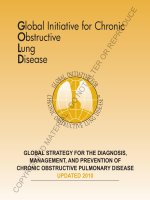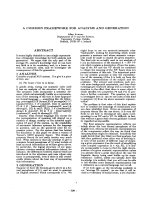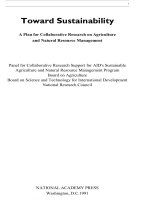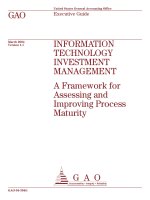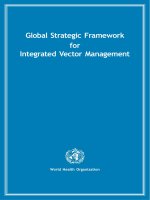Global Strategic Framework for Integrated Vector Management pot
Bạn đang xem bản rút gọn của tài liệu. Xem và tải ngay bản đầy đủ của tài liệu tại đây (76.54 KB, 15 trang )
Global Strategic Framework
for
Integrated Vector Management
World Health Organization
© World Health Organization 2004
All rights reserved.
The designations employed and the presentation of the material in
this publication do not imply the expression of any opinion whatsoever
on the part of the World Health Organization concerning the legal
status of any country, territory, city or area or of its authorities, or
concerning the delimitation of its frontiers or boundaries. Dotted
lines on maps represent approximate border lines for which there
may not yet be full agreement.
The mention of specific companies or of certain manufacturers’
products does not imply that they are endorsed or recommended by
the World Health Organization in preference to others of a similar
nature that are not mentioned. Errors and omissions excepted, the
names of proprietary products are distinguished by initial capital
letters.
The World Health Organization does not warrant that the information
contained in this publication is complete and correct and shall not be
liable for any damages incurred as a result of its use.
Global Strategic Framework
for
Integrated Vector Management
World Health Organization
Geneva, 2004
WHO/CDS/CPE/PVC/2004.10
CONTENTS
Preface 3
1. Purpose 4
2. Why a Global Strategic Framework? 4
3. Integrated vector management 7
4. Key elements of an IVM strategy 10
5. Next steps 11
Preface
Malaria and other vector-borne diseases are major contrib-
utors to the total global burden of disease and a significant
impediment to socioeconomic development in resource-
poor countries. Although vector control has a proven record
of saving lives by preventing, reducing or eliminating
transmission, its benefits are far from being fully realized.
The Global Strategic Framework for Integrated Vector
Management (IVM) provides a basis for strengthening
vector control in a manner that is compatible with national
health systems. Through evidence-based decision-making,
IVM rationalizes the use of human and financial resources
and organizational structures for the control of vector-
borne disease and emphasizes the engagement of
communities to ensure sustainability. It encourages a multi-
disease control approach, integration with other disease
control measures and the considered and systematic
application of a range of interventions, often in combi-
nation and synergistically.
A guiding principle is that effective control is not the
sole preserve of the health sector but requires collaboration
with various other sectors together with public and private
agencies and institutions. Implementation of this strategy
will require effective public health regulation and legislation,
allied to a strong commitment and concerted action by
the World Health Organization, working in coordination
with the Food and Agriculture Organization of the United
Nations, the United Nations Environment Programme, other
United Nations agencies and donors, and Member States.
Global Strategic Framework for Integrated Vector Management
3
1. Purpose
The Global Strategic Framework on Integrated Vector
Management (IVM) sets out new and broad principles and
approaches to vector control that are applicable to all vector-
borne diseases. Integrated vector management seeks to improve
the efficacy, cost-effectiveness, ecological soundness and
sustainability of disease vector control. This Framework is
intended to provide orientation to policy-makers within WHO
and Member States on the development and implementation
of IVM, and to strengthen collaboration with donors and other
United Nations agencies, notably the Food and Agriculture
Organization of the United Nations (FAO) and the United Nations
Environment Programme (UNEP).
2. Why a Global Strategic Framework?
In its 2001 report, the Commission on Macroeconomics and
Health
1
documented the enormous benefits for health and
socioeconomic development that flow from effective control
of vector-borne diseases. It recognized that the fight against
disease requires not only financial resources, appropriate
technology and political commitment, but also a strategy,
operational lines of responsibility and adaptive management
systems, able to learn from and correct mistakes. IVM seeks to
apply such principles to the control of vectors of disease.
Vector-borne diseases are responsible for a significant fraction
of the global disease burden and have profound effects not
only on health but also on the socioeconomic development of
affected nations. Thus, an econometric model for malaria —
which is responsible for more than 1 million deaths every year
— suggests that countries with intensive malaria have income
levels only 33% of those without malaria.
Vector control has a proven record in the prevention and control
of vector-borne disease. The distribution and incidence of
1
Commission on Macroeconomics and Health. Macroeconomics and health: investing in health
for economic development. Geneva, World Health Organization, 2001.
Global Strategic Framework for Integrated Vector Management
4
vector-borne disease are strongly determined by the ecological
conditions that favour different species of disease vector.
Knowledge and understanding of these characteristics provide
a unique opportunity to prevent and control such diseases, by
reducing vector–human contact and vector population density
and survival.
IVM is based on the premise that effective control is not the
sole preserve of the health sector but requires the collaboration
of various public and private agencies and community
participation. The engagement of communities is a key factor
in assuring sustainability. IVM entails the use of a range of
interventions of proven efficacy, separately or in combination,
in order to implement more cost-effective control and reduce
reliance on any single intervention. This strategy also serves to
extend the useful life of insecticides and drugs by reducing
the selection pressure for resistance development.
IVM includes organization at the local level and the estab-
lishment of effective and broadly based local partnerships. At
the other end of the scale, countries and donors should be
encouraged to develop partnerships and operate within adaptive
management systems. Major funding initiatives should include
adequate provision for IVM to speed progress in the control of
vector-borne disease.
The success of programmes such as the integrated control of
malaria in the Zambian Copper Belt in the 1930s and 1940s, the
current initiative against Chagas disease vectors in Latin America,
and the West African Onchocerciasis Control Programme since
the 1970s demonstrate that strategically sound, well-coordi-
nated and sustained initiatives can bring enormous benefits in
improved health and socioeconomic development. A key feature
contributing to their success has been effective management
based on the use of robust systems for monitoring, evaluation
and reporting, and procedures for the rapid identification and
correction of problems. The adoption of a strategy for IVM
provides new opportunities for effective action against vector-
borne disease, using the lessons learned from these and other
successful initiatives.
Global Strategic Framework for Integrated Vector Management
5
For many vector-borne diseases there are no vaccines, and drug
resistance — or the threat of resistance — is an increasing
problem. In such circumstances vector control often plays a
vital role. In some cases, and dengue is one example, effective
vector control is the primary or even sole measure for
preventing disease outbreaks.
Vector control programmes have relied heavily on the use of
residual insecticides and the selective use of such compounds
is likely to continue, as a part of IVM. For example, insecticide-
treated nets are currently used in the control of malaria and
other vector-borne diseases, with minimal impact on ecosystems
and the environment. The Onchocerciasis Control Programme
eliminated the disease from much of the programme area using
various insecticides in rotation, and the Southern Cone
Initiative for the control of Chagas disease in South America
has relied primarily on spraying inside houses with residual
insecticides to achieve its objectives of elimination. However,
the environmental and health concerns over persistent organic
pollutants identified in the Stockholm Convention, together
with the increasing problem of insecticide resistance, empha-
size the need for alternative strategies for sustainable vector
control and management. Such considerations led to World
Health Assembly resolution WHA 50.13, which called on Member
States to support the development and adoption of viable
alternative methods of controlling vector-borne diseases and
thereby reduce reliance on insecticides. IVM provides a man-
agement framework within which such changes can be effected.
Although many vector-borne disease control programmes
continue to rely heavily on vector control, the benefits are far
from being fully realized. Reasons for this include the following:
• The skills to both manage and implement vector control
programmes remain scarce, particularly in the resource-poor
countries that are in most need of effective vector-borne
disease control. This has led to control measures that are
unsuitable or poorly targeted, with insufficient coverage and
consequent wastage of resources and sometimes avoidable
insecticide contamination of the environment.
Global Strategic Framework for Integrated Vector Management
6
• The use of insecticides in agriculture and poor management
of insecticides in public health programmes have contributed
to resistance in disease vectors.
• Development programmes, including irrigated agriculture,
hydroelectric dam construction, road building, forest
clearance, housing development and industrial expansion,
all influence vector-borne diseases but opportunities for
cooperation between sectors and for adoption of strategies
other than those based on insecticides are seldom grasped.
In addition, health sector reform, with its emphasis on
decentralization of operational control, poses new challenges
but also affords significant new opportunities for delivering
vector control.
This Global Strategic Framework for integrated vector
management has been developed both to address deficiencies
in vector control and to improve the efficacy, cost-effec-
tiveness, ecological soundness and sustainability of that
control. More effective disease vector control will make a
significant contribution to the attainment of the Millennium
Development Goals.
3. Integrated vector management
Integrated vector management is a process for managing vector
populations in such a way as to reduce or interrupt transmission
of disease. Characteristic features of IVM include:
• methods based on knowledge of factors influencing local
vector biology, disease transmission and morbidity;
• use of a range of interventions, often in combination and
synergistically;
• collaboration within the health sector and with other public
and private sectors that impact on vectors;
• engagement with local communities and other stakeholders;
•a public health regulatory and legislative framework.
Global Strategic Framework for Integrated Vector Management
7
An IVM-based process should be cost-effective, should have
indicators for monitoring efficacy with respect to impact on
vector populations and disease transmission, and should employ
sustainable approaches compatible with local health systems.
It should also allow effective planning and decision-making to
take place at the lowest possible administrative levels
(subsidiarity).
IVM has benefited from experience with integrated pest
management (IPM) systems used in agriculture. Although
insecticides have proved effective in protecting increased crop
yields, their adverse environmental and health effects and the
development of insecticide resistance have required the intro-
duction of pest management systems encompassing all methods
that have an impact on the pest problem. Such integrated
approaches help to preserve ecosystem integrity and encourage
the propagation of natural enemies of pest species, such as
pathogens and predators. Making better use of environmental,
biological and other measures can extend the useful life of
insecticides so that they are available when and where the
need is greatest. Crucially, economic analysis has shown that
IPM systems are ultimately more cost-effective than heavy
reliance on insecticides, even without considering the economic
impacts of environmental contamination and unwanted side-
effects.
Similar principles apply to the control of insect disease vectors
for which evidence-based, cost-effective and sustainable
approaches are needed. However, it should be recognized that
the success of IPM systems is due, in part, to the fact that
farmers see direct results in the form of increased crop yields
and better management of irrigation water, and are able to enjoy
the economic benefits. In contrast, the improvements in health
resulting from control of vector-borne disease can be more
difficult to measure and the associated economic benefits for
the community are less obvious.
An additional and key impetus to the adoption of IVM arises
out of the need to ensure the sound management and judicious
use of insecticides, as requested by the World Health Assembly
Global Strategic Framework for Integrated Vector Management
8
and the Stockholm Convention on Persistent Organic Pollutants.
This has led to a reappraisal of the strategy for vector control
and a commitment to the development of effective measures
that reduce risk and are compatible with protection of the
environment and sustainable development. Such a commitment
requires an approach that effectively integrates the roles of
the various sectors, including health, within a strategic
management framework.
An IVM approach takes into account the available health
infrastructure and resources and integrates all available and
effective measures, whether chemical, biological or environ-
mental. IVM also encourages effective coordination of the
control activities of all sectors that have an impact on vector-
borne diseases, including health, water, solid waste and sewage
disposal, housing and agriculture. Commensurate benefits for
non-health-sector partners make it more likely that IVM
approaches will be effective. For example, alternate wet/dry
(intermittent) irrigation, combined with other vector control
methods, has been effective in controlling the vectors of
malaria and Japanese encephalitis in China, India, Indonesia
and Sri Lanka. It also allows a more economic usage of irrigation
water, thereby reducing farmers’ costs.
An IVM approach is evidence-based and an essential feature is
development of the capacity to generate local data on disease
epidemiology and vector ecology. IVM integrates all available
resources to achieve a maximum impact on vector-borne
disease.
Integration at the level required for IVM is not a simple task —
national leadership and adequate local capacity are essential.
Commitment is needed from central government to integrate
IVM within national policies and from municipal and local health
authorities to coordinate their work in a manner not yet seen
in most Member States. As was recognized more than 20 years
ago by the joint WHO/FAO/UNEP/UNCHS Panel of Experts on
Environmental Management for Vector Control (PEEM), ministries
of health do not have a strong voice in decisions on financing
and the planning of development.
Global Strategic Framework for Integrated Vector Management
9
This means that the governments and international bodies that
fund development projects should respect the principles
inherent in IVM and ensure that recipient countries have the
funds for human resource development and training in all
aspects of IVM. Existing bodies outside the health sector, such
as national economic planning councils, environmental
protection agencies and national councils for science and
technology, should be explored as vehicles by which the funding
of IVM could be embedded in national policy.
While IVM emphasizes effective systems and action at the local
level, the support of nationwide programmes is essential for
major diseases such as malaria, dengue and filariasis. These
programmes will be required to provide technical advice on
vector-borne disease epidemiology, surveillance and control
technologies, and to provide adequate systems for programme
monitoring and quality control. However, successful vector
control programmes need more than just expertise in vector
control technologies — they also need expertise in planning
and programme management. The requisite skills remain scarce,
particularly in the resource-poor countries that are most in need
of effective vector-borne disease control. A massive effort will
be required to build the capacity to address these various facets
of IVM.
4. Key elements of an IVM strategy
Effective IVM requires the establishment of principles, decision-
making criteria and procedures, together with time frames and
targets. These principles need to be incorporated into national
health policies and supported by legislation and regulation. To
be successful, IVM requires an inventory of essential functions
and organizational structures that optimize the use of financial,
human and technical resources for vector-borne disease control.
The key elements are:
• Advocacy, social mobilization and legislation
Promotion and embedding of IVM principles in development
policies of all relevant agencies, organizations and civil
Global Strategic Framework for Integrated Vector Management
10
society; establishment or strengthening of regulatory and
legislative controls for public health; empowerment of
communities.
• Collaboration within the health sector and with other
sectors
Consideration of all options for collaboration within and
between public and private sectors; application of the
principles of subsidiarity in planning and decision-making;
strengthening channels of communication among policy-
makers, vector-borne disease control programme managers
and other IVM partners.
• Integrated approach
Ensure rational use of available resources through application
of a multi-disease control approach, integration of non-
chemical and chemical vector control methods, and
integration with other disease control measures.
• Evidence-based decision-making
Adaptation of strategies and interventions to local vector
ecology, epidemiology and resources, guided by operational
research and subject to routine monitoring and evaluation.
• Capacity-building
Development of essential physical infrastructure, financial
resources and adequate human resources at national and
local level to manage IVM programmes based on a situation
analysis.
5. Next steps
This Strategic Framework is merely a first step in the process
leading to implementation of IVM. The effective control of
vector-borne diseases cannot be achieved by the health sector
alone. The adoption of IVM affords WHO and Member States an
opportunity to work with international agencies, non-
governmental organizations, donors and the private sector to
optimize the use of financial, human and technical resources
for vector-borne disease control.
Global Strategic Framework for Integrated Vector Management
11
To achieve these goals and create strong and effective advocacy
for IVM, WHO should strengthen the existing linkages and
coordination with FAO, UNEP and other agencies, many of
which already support programmes based on IVM . A strategic
plan for the implementation of IVM should be developed. WHO
should also take the actions necessary to formally endorse the
IVM approach to vector-borne disease control.
Global Strategic Framework for Integrated Vector Management
12
For more information, please contact:
CDS Information Resource Centre
World Health Organization
1211 Geneva 27 – Switzerland
Fax +(41) 22 791 4285
E-mail:
